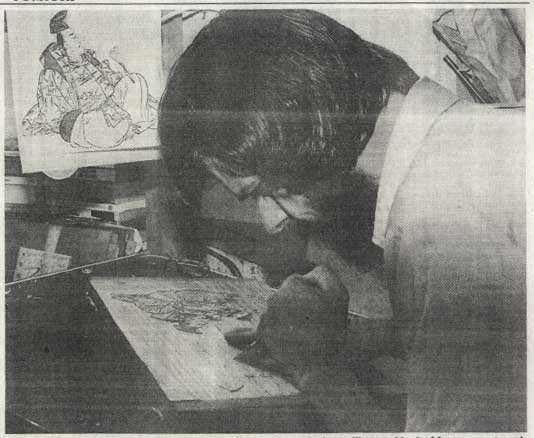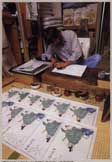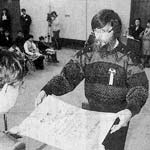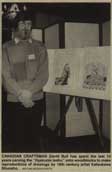Recapturing Edo Images
Squatting in front of a photocopy of an ukiyo-e print in the light from a 50-watt bulb, David Bull puts his carving knife carefully to a block of cherry wood. Under his blade, the image of an elaborately robed Heian minister slowly begins to emerge.
"The hardest thing about making woodblock prints is the carving of intricate lines - you have to be able to use your knife like a brush in order to do justice to the fine lines," Bull says.
Bull has taken on the monumental task of recreating a collection of 100 ukiyoe-style woodblock prints using techniques from the Edo era.
The collection that Bull chose is from a rare book published in 1775. The book contains portraits of the Hyakunin Isshu poets made by Katsukawa Shunsho. According to Bull, Shunsho was "the leading designer of the 1770s just before Utamaro."
Bull, a 37-year-old Canadian, claims to be the only foreign carver and printmaker in Japan working in the intricate ukiyo-e style. He says he has always had a great passion for Japanese woodblock printing.
"Although I did not have any background in art," he says, "I developed a strong interest in traditional woodblock printing eight years ago, when I was still in Canada."
Seven years ago, Bull made a three-month trip to Japan, learning as much as he could about the art from professionals in the field. In 1986, his interest in the art and a keen desire to develop his skills finally lured him and his family to Japan.

Bull's decision to take on the current project, however, came by accident.
"It all started when I came across the book last year at a Tokyo museum," he says.
Bull says he fell in love with the 18th century volume the minute he saw it.
"What is special about the collection is that the characters are portrayed not in a stylized, expressionless manner, as was frequently the case when depicting historical figures of this type, but as individuals with personality and character," he says.
"The lines of the gorgeous kimono sweep across the page and are balanced by the delicate calligraphy of the artist Shunsho, who in addition to the figures, also drew the poetry."
Although Bull's original intention was to produce copies of the collection for his own personal enjoyment and study, it was not until he completed the first print of the series that he decided to seriously take on the project.
"This January, I completed the first print of the series," he says. "When I showed it to a friend, he told me that he wanted a copy, too.
"It was then that I perceived the completion of the entire collection as an opportunity to not only perfect my skills, but a chance to actually earn a living as a real shokunin (craftsman)."
To capture the spirit of Shunsho's drawings and calligraphy exactly as they were produced more than 200 years ago, Bull decided to reproduce the entire series page by page using traditional techniques and materials used by Edo-period carvers and printers.
The greatest challenge for Bull, however, is having to juggle the tasks of carving, printing and publishing.
"Traditionally, these tasks were done by three individual artisans," Bull explains.
As a result, progress on the project has been slow. Since March, Bull has only been able to produce five prints.
"At this rate, the project will most likely take me a good 10 years to complete - it will be a lifelong project," he says.
But speed is not what Bull is after.
"As I see each print in the series come to life under my hands, I experience a tremendous thrill of satisfaction and accomplishment," he says. "I want to get better with each print."
Bull says he has no desire to produce his own original designs.
"My only desire is to be a good shokunin, like those in the days of Edo."
There are only 20 carvers in Japan still producing woodblock prints in the traditional art form, and Bull is the only foreigner among them.
Because half of those carvers are well into their 70s, it appears that the best chance of preserving the art lies in the busy hands of David Bull.
TV Listings
The 'Woodblock Shimbun' has a full selection of TV programs on file. Videos available include some of David's news appearances, complete feature programs, and some short documentaries on his work. The files are in QuickTime format, and can be easily viewed with your browser.
Program listings are on the Index page ... ![]()
Enchanting Japan
Colourful woodblock prints - for people all over the world, to hear this phrase is to think of Japan. Japan has a long history of woodblock printing, or hanga, originally for illustrations for books. By the late seventeenth century, hanga in the ukiyo-e style came into its own as an art form, and prints came to be appreciated on their own merits. The many woodblock prints that accurately depict life in the Edo period are excellent examples of this tradition. Whether a print of a geisha, a kabuki actor strutting on stage, or even a completely modern image, the woodblock printing technique seems to provide the perfect means of expression to capture the essence of things Japanese. (1998)
Full Story. ![]()
Canadian artist wins top prize of 1,000,000 yen in Essay Contest
David Bull, a citizen of Canada and Britain, received 1,000,000 yen, the top award, for his winning essay in the fourth annual "Save the Earth" contest on Saturday at the Yomiuri Shimbun headquarters in Tokyo ... (1994)
Full Story. ![]()
Woodblock Man Carves Niche
Woodblock carver David Bull refuses to be called an 'artist' or 'sensei'. "I'm just the guy who carves a piece of wood," Bull said. "All I do is copy what the real artists did." Since 1989, the Canadian university dropout who once played the flute on the streets of London has spent many hours bent over his woodblocks, nose and beard almost touching the surface, as he carved toward a self-appointed goal: the recreation of 18th century ukiyo-e artist Katsukawa Shunsho's 'Hyakunin Isshu: Poems from One Hundred Poets' series. (1999)
Full Story. ![]()




